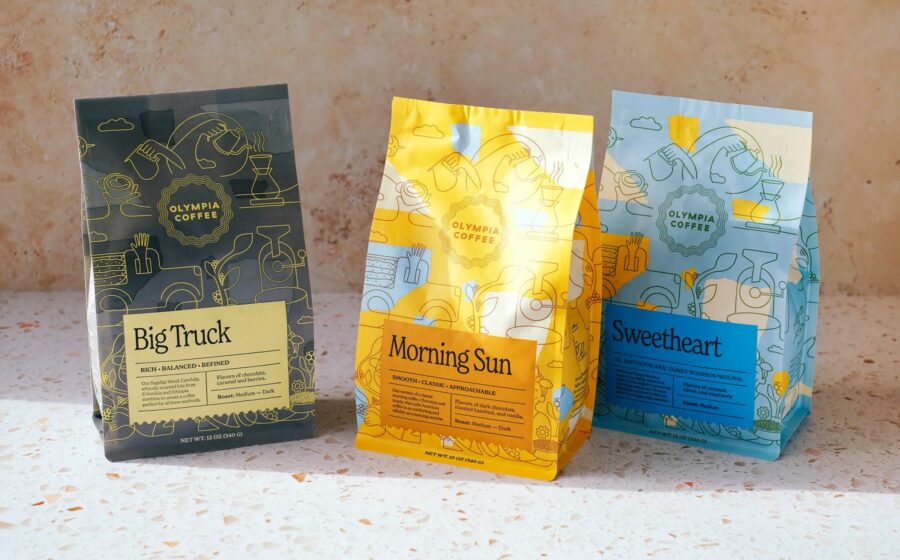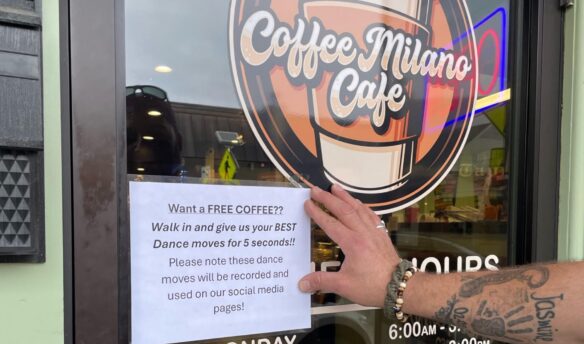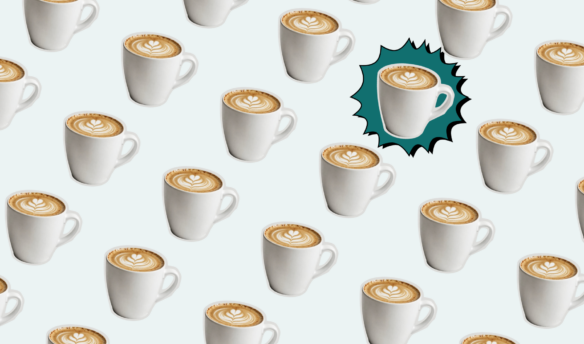You’d be forgiven for thinking that coffee bag design is straightforward—just add bright colors and bold lettering to catch a customer’s eye. But the real value of a well-designed coffee bag goes beyond the aesthetics. For many coffee drinkers, it’s their first introduction to a roaster, and every detail—from tasting notes to information about partner farmers—conveys the brand’s ethos and story.
It’s clear that design is only one part of what makes a coffee bag stand out to customers. Brands also need to consider how much information to include their packaging. From coffee factoids like elevation and region to processing methods and varietals, how can roasters decide what information buyers really need to choose a coffee they’ll love?
Strategic Design Impacts Production
For Olympia Coffee Roasting Co. in Washington State, the question of what to include on its coffee bags came into focus when the company redesigned its packaging in 2023. Co-owner Sam Schroeder says they update their packaging every few years as the company grows.
“Every company goes through an evolution over time, and having our brand reflect who we are right now is part of that process,” he says of Olympia, a brand that has been roasting coffee since 2005. “We periodically rebrand different elements to better reflect the company we are today.”
From origin to roast profile, Olympia’s team knows through experience that the details on a coffee bag tell the story of what’s inside, and help customers pick a coffee they’ll love. But they also know that coffee bag design must align with the business’s own capabilities.
Before the redesign, Olympia Coffee’s bags had labels on both the front and back, featuring specific details about the beans inside. The recent update, however, consolidated the information onto a single front label. Schroeder says this change was driven by the need to streamline a labor-intensive part of their production: manually applying labels.
“There was a lot of manual work in prepping our bags,” he says. “You’re taking off a sticker, applying the front label to the bag, switching it over and doing it for the back labels.” Each bag also got a date stamp, indicating the day it was roasted, which was done by hand.
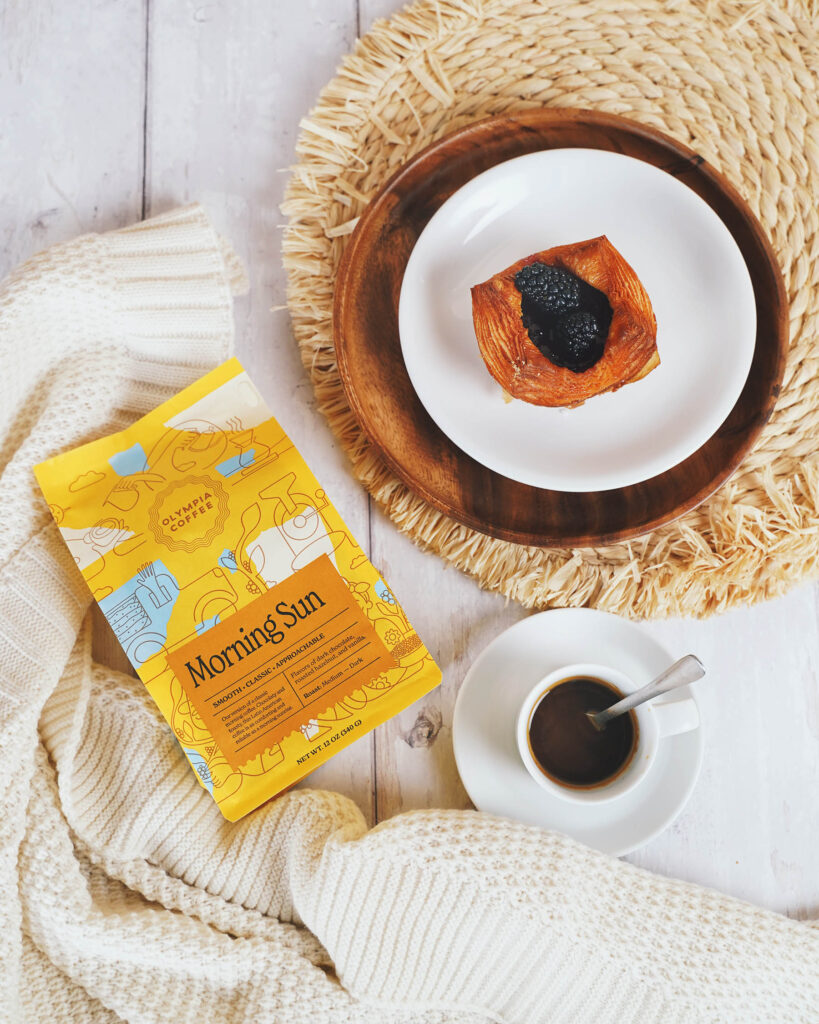
As roast volumes increased, packaging and production became a bottleneck in the roastery. In response, the Olympia team simplified their packaging by separating their house blends from their one-off, single-origin releases. Both types feature the company story on the back, while the front label provides key coffee details, but only the single-origin front labels are still applied by hand.
Schroeder says they also no longer stamp their bags by hand. Instead, they use a band sealer that seals the bags to protect them from oxygen and automatically prints the roast date as they move through the machine. “We still include the roast date on every bag, but we don’t have to physically do that ourselves,” he says.
Finding the Sweet Spot
Knowing a coffee’s country of origin is just the starting point for many coffee lovers, and roasters need to strike a balance between providing enough context to engage without overwhelming the customer with detail.
Maciej Kasperowicz from Trade Coffee, a coffee subscription service, says there aren’t strict rules for every roaster, and the level of detail to include on any packaging depends on the audience. “For single origins, naming the country is a bare minimum,” he says. “But for those offering premium coffees, it makes sense to have the region and farm on the bag.”
Schroeder agrees that the level of detail should reflect a company’s values. “It depends on the kind of company you want to be and what’s important to you,” he says. For Olympia, the details matter, because it sources distinct varieties from specific partner farms.
“It’s important that coffee is not anonymous. We want to get as specific as possible with the elements that communicate what the flavor is to the coffee,” Schroeder adds, pointing out that factors like elevation and processing method can help informed customers set expectations about what a coffee will taste like.
While single-origin coffees may benefit from detailed information on the bag, blends are trickier. Given that they comprise multiple coffees, it’s harder to list detailed origin info without overwhelming the customer.
Price can be a good rule of thumb to dictate how much detail should go on the packaging. Schroeder points to a coffee Olympia previously brought in from producer Milton Monroy (the coffee is not currently on the menu), an anaerobically processed gesha from Colombia. In this case, the coffee bag includes more information to show what sets it apart. “This is expensive coffee,” he says. “If we just put ‘Colombian coffee’ on the bag, what makes it different?”
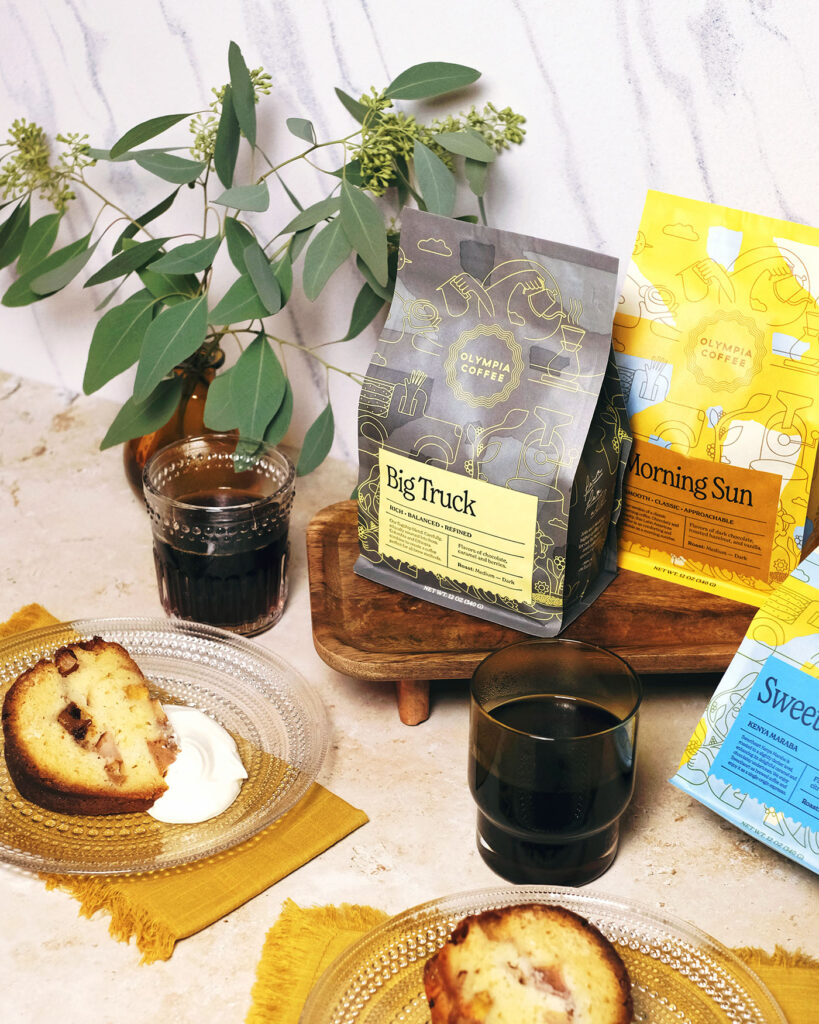
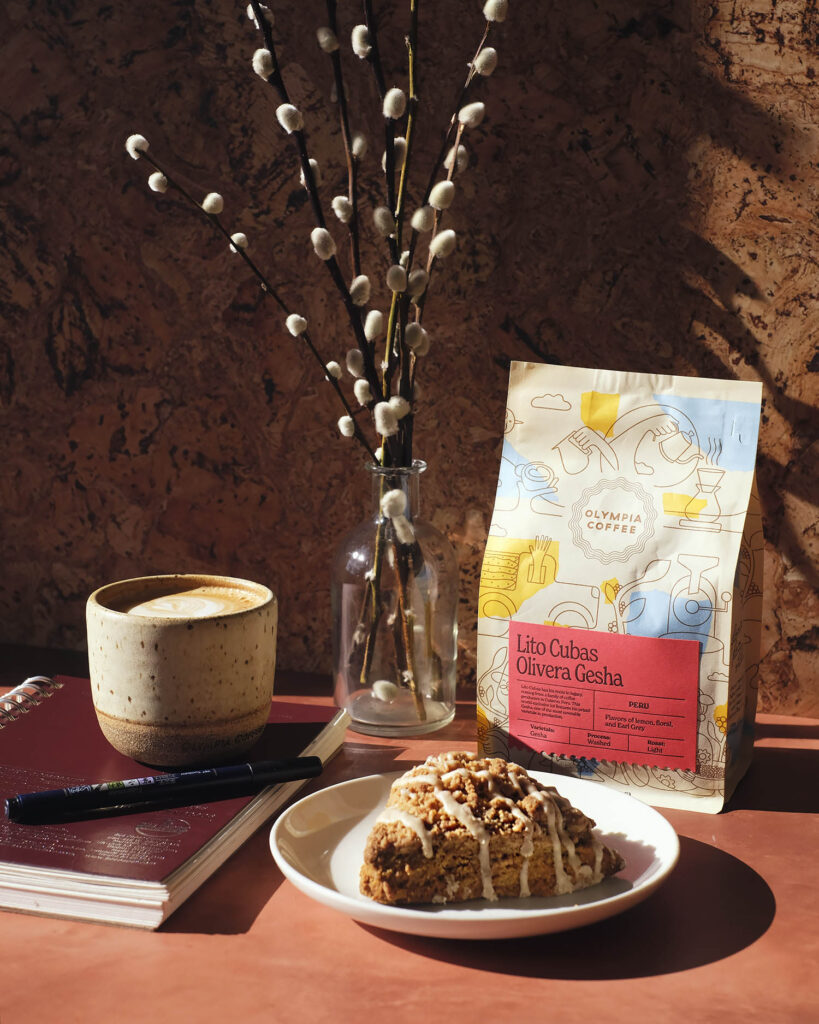
Schroeder notes that Olympia often carries multiple coffees from the same country simultaneously, and getting specific by naming the producer or region can also help convey to customers that they’re getting a coffee with a distinct character and story. “Milton Monroy is a specific farmer who is famous for high quality,” he says. “When we have a specific farmer, we might put that upfront or use the producer group as the name of the coffee.”
By contrast, for blends like Olympia’s Morning Sun, the essentials—tasting notes, roast level, and a brief description—are front and center. It’s labeled simply as Latin American coffee, without specifics on the countries of origin or producers. On the other hand, the roaster’s single-origin bags necessarily dive deeper, including details like the country, producer, farm name, elevation, varietal, and process.
Kasperowicz believes that while listing a coffee’s variety (think bourbon, typica, and others) isn’t a major buying factor, some customers value details about specific varieties and elevation. “If you’re selling a gesha, you have to put that somewhere,” he says of the highly prized (and oftentimes expensive) varietal.
While some of these factoids may not be a deciding factor for customers, they can still signal that a roaster cares about the details. “Some customers may not be shopping specifically by elevation, but they appreciate seeing ‘this is a roaster who is happy to give me all these details,’” Kasperowicz says.
For Olympia, it all comes down to communicating the qualities that contribute to a coffee’s flavor. “Not everyone knows what a washed process or natural processed coffee tastes like, or what the difference is,” Schroeder says. “But if you do, it gives you a lot of information about what that coffee might taste like.”
Making Space for What Counts
In addition to the technical specs of a given coffee’s production, many roasters also include tasting or flavor notes on their coffee bags. Some notes are specific, like “caramel” or “s’mores,” while others are broader, such as “bright” or “juicy.” But are these notes essential?
Kasperowicz finds tasting notes useful for customers, but says that hyper-specific labels often serve more as branding elements, the flavor descriptions speaking more to the story a roaster is telling about themselves and the coffees they bring in. He says they’re “not necessarily an advantage unless they build the vibe you’re aiming for.”
When Olympia redesigned its bags, it added the coffee’s roast level, something it had omitted for years but brought back because of frequent customer questions. “It is a huge contributor to the flavor of the coffee,” Schroeder says. “If you ask most people what kind of coffee they like, they’ll usually start with roast level, even before country of origin, variety, or process.”
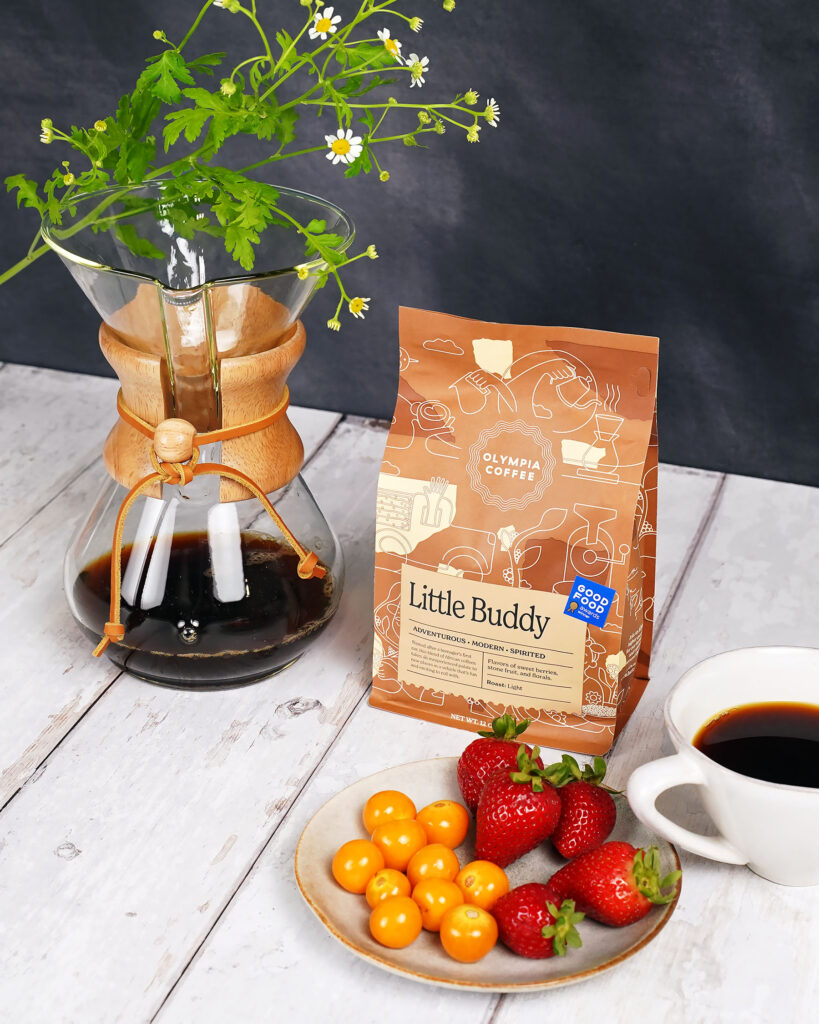
When deciding what to put on coffee packaging, roasters should also consider whether their customers primarily shop online or in person.
Kasperowicz points out that the amount of detail on coffee packaging matters more for in-store customers, who rely on the bag for information. Bag details might not be as important to online shoppers who can find out more on the website. “There are a lot of different ways to communicate that information,” he says.
For the team at Olympia, simplifying their coffee bag labels has pushed them to be more concise. Once packed with details about coffee origins, producers, and trade programs, the packaging now highlights only the essentials. To offer a deeper look, Olympia is now expanding its website, adding in-depth content like videos that goes beyond what a label can hold.
It’s an important point to remember: Roasters who want to ensure their customers have access to information aren’t just limited to their packaging as a medium for sharing their story. “We want to share more of that information for people who want to reach farther,” Schroeder says of Olympia’s website. As long as roasters keep their audience in mind across all platforms and align that need with their own production capabilities, they’re sure to connect with customers.



